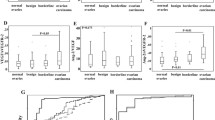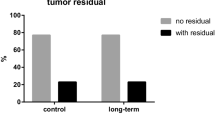Abstract
Introduction
Endothelial-cell-specific molecule-1 or endocan is a proteoglycan with tumorigenic activity through both its glycan and protein cores. Endocan mRNA is identified as one of the most significant molecular signatures defining a poor prognosis in lung, breast, kidney, and hepatocellular cancer.
Objective
To assess the clinical value of endocan expression in ovarian cancer tissues in association with other prognostic factors and its impact on overall survival.
Setting
Oncology unit of Zagazig University Hospitals, Egypt.
Study design
Prospective observational cohort.
Patients and methods
One hundred primary ovarian cancer patients were recruited as study group, another 100 patients undergoing hysterectomy and oophorectomy due to uterine fibroid were the control group. Angiogenesis was determined by immunohistochemical staining, using anti-endocan, and anti vascular endothelial growth factor (VEGF) monoclonal antibodies.
Results
Endocan was expressed in endothelium of ovarian cancer tissue specimens in all patients with no expression in endothelium of normal ovarian tissue in the control group. VEGF was also expressed in endothelium of all specimens of ovarian cancer tissue, compared with 70 % expression in normal ovarian tissue specimens in the control group. A significant association was found between endocan-microvessel density (MVD) and tumor histology, tumor size, staging, and grading. No significant association was found between VEGF expression and any of the clinicopathological variables. Overall survival of patients was inversely associated with endocan-MVD (P < 0.01). Multivariate analysis showed that endocan-MVD was an independent prognostic marker for overall survival of epithelial ovarian cancer (P < 0.01).
Conclusion
Endocan could be a reliable marker to predict the survival in epithelial ovarian cancer patients.
Similar content being viewed by others
References
Heintz AP, Odicino F, Maisonneuve P, Quinn MA, Benedet JL, Creasman WT et al (2005) Carcinoma of the ovary. FIGO 26th annual report on the results of treatment in gynecological cancer. Int J Gynaecol Obstet 95(Suppl 1):S161–S192
Collinson FJ, Seligmann J, Perren TJ (2012) Ovarian cancer: advances in first-line treatment strategies with a particular focus on anti-angiogenic agents. Curr Oncol Rep (Epub ahead of print)
Eskander RN, Tewari KS (2012) Emerging treatment options for management of malignant ascites in patients with ovarian cancer. Int J Womens Health 4:395–404
Fruscio R, Corso S, Ceppi L, Garavaglia D, Garbi A, Floriani I, Franchi D (2012) Conservative management of early-stage epithelial ovarian cancer: results of a large retrospective series. Ann Oncol (Epub ahead of print)
Goodheart MJ, Ritchie JM, Rose SL, Fruehauf JP, De Young BR, Buller RE (2005) The relationship of molecular markers of p53 function and angiogenesis to prognosis of stage I epithelial ovarian cancer. Clin Cancer Res 11:3733–3742
Rubatt JM, Darcy KM, Hutson A, Bean SM, Havrilesky LJ, Grace LA, Berchuck A, Secord AA (2009) Independent prognostic relevance of microvessel density in advanced epithelial ovarian cancer and associations between CD31, CD105, p53 status, and angiogenic marker expression: a Gynecologic Oncology Group Study. Gynecol Oncol 112:469–474
Wang Y, Mao H, Hao Q, Wang Y, Yang Y, Shen L, Huang S, Liu P (2012) Association of expression of XIAP-associated factor 1 (XAF1) with clinicopathologic factors, overall survival, microvessel density and cisplatin-resistance in ovarian cancer. Regul Pept 178(1–3):36–42
Bock AJ, Tuft Stavnes H, Kærn J, Berner A, Staff AC, Davidson B (2011) Endoglin (CD105) expression in ovarian serous carcinoma effusions is related to chemotherapy status. Tumour Biol 32(3):589–596
Ferrero A, Dompè D, Ravarino N, Ramella A, Fuso L, Maggiorotto F, Tripodi E, Zola P (2011) Angiogenesis and molecular markers in advanced epithelial ovarian cancer: a retrospective study. Gynecol Oncol 123(2):301–307
Fiedler U, Christian S, Koidl S, Kerjaschki D, Emmett MS et al (2006) The sialomucin CD34 is a marker of lymphatic endothelial cells in human tumors. Am J Pathol 168:1045–1053
Folkman J, Klagsbrun M (1987) Angiogenic factors. Science 235:442–447
Sarrazin S, Adam E, Lyon M, Depontieu F, Motte V, Landolfi C, Lortat-Jacob H, Bechard D, Lassalle P, Delehedde M (2006) Endocan or endothelial cell specific molecule-1 (ESM-1): a potential novel endothelial cell marker and a new target for cancer therapy. Biochem Biophys Acta 1765:25–37
van’t Veer LJ, Dai H, van de Vijver MJ, He YD, Hart AA, Mao M et al (2002) Gene expression profiling predicts clinical outcome of breast cancer. Nature 415:530–536. doi:10.1038/415530a
Chen LY, Liu X, Wang SL, Qin CY (2010) Over-expression of the endocan gene in endothelial cells from hepatocellular carcinoma is associated with angiogenesis and tumour invasion. J Int Med Res 38(2):498–510
Grigoriu BD, Depontieu F, Scherpereel A, Gourcerol D, Devos P, Ouatas T (2006) Endocan expression and relationship with survival in human non-small cell lung cancer. Clin Cancer Res 12(15):4575–4582
Poon RT, Ng IO, Lau C et al (2002) Tumor microvessel density as a predictor of recurrence after resection of hepatocellular carcinoma: a prospective study. J Clin Oncol 20:1775–1785
Zuo L, Zhang SM, Hu RL, Zhu HQ, Zhou Q, Gui SY (2008) Correlation between expression and differentiation of endocan in colorectal cancer. World J Gastroenterol 14(28):4562–4568
Cornelius A, Cortet-Rudelli C, Assaker R, Kerdraon O, Gevaert MH, Prévot V (2012) Endothelial expression of endocan is strongly associated with tumor progression in pituitary adenoma. Brain Pathol 22(6):757–764
Weidner N (1995) Current pathologic methods for measuring intratumoral microvessel density within breast carcinoma and other solid tumors. Breast Cancer Res Treat 36:169–180
McDonald DM, Foss AJE (2000) Endothelial cells of tumor vessels: abnormal but not absent. Cancer Metastasis Rev 19:109–120
Abid MR, Yi X, Yano K, Shih SC, Aird WC (2006) Vascular endocan is preferentially expressed in tumor endothelium. Microvasc Res 72:136–145
Rennel E, Mellberg S, Dimberg A, Petersson L, Botling J, Ameur A et al (2007) Endocan is a VEGF-A and PI3K regulated gene with increased expression in human renal cancer. Exp Cell Res 313:1285–1294
Conflict of interest
We have no conflict of interest.
Author information
Authors and Affiliations
Corresponding author
Rights and permissions
About this article
Cite this article
El Behery, M.M., Seksaka, M.A., Ibrahiem, M.A. et al. Clinicopathological correlation of endocan expression and survival in epithelial ovarian cancer. Arch Gynecol Obstet 288, 1371–1376 (2013). https://doi.org/10.1007/s00404-013-2863-3
Received:
Accepted:
Published:
Issue Date:
DOI: https://doi.org/10.1007/s00404-013-2863-3




